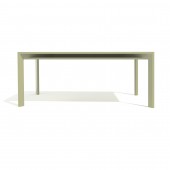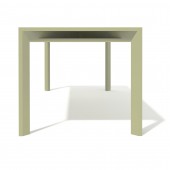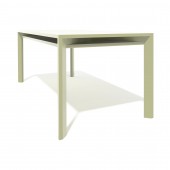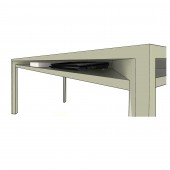
| THE AWARD |
| CATEGORIES |
| REGISTRATION |
| SUBMIT YOUR WORK |
| ENTRY INSTRUCTIONS |
| TERMS & CONDITIONS |
| PUBLICATIONS |
| DATES & FEES |
| METHODOLOGY |
| CONTACT |
| WINNERS |
| PRESS ROOM |
| GET INVOLVED |
| DESIGN PRIZE |
| DESIGN STORE |
| THE AWARD | JURY | CATEGORIES | REGISTRATION | PRESS | WINNERS | PUBLICATIONS | ENTRY INSTRUCTIONS |
Tavolo Livelli Table by Wouter van Riet Paap |
Home > Winners > Design #30098 >Interview |
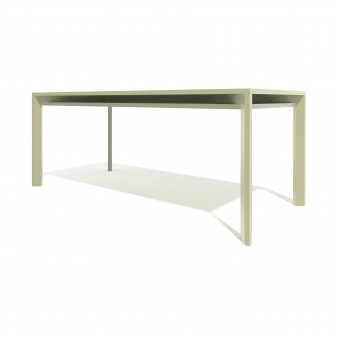 |
|
FS: What is the main principle, idea and inspiration behind your design?
Wv: The main principle is to keep things simple yet sophisticated. The Tavolo Livelli was designed to create extra space for storage in my rather small house. And since you need a table anyway, why not use the otherways spoiled space under the table.
FS: What has been your main focus in designing this work? Especially what did you want to achieve?
Wv: Most important was to keep the table exciting. I did this by placing the table legs under 45 degrees and cutting their front under 45 degrees again, this way all faces are exactly 25 mm in view.
FS: What are your future plans for this award winning design?
Wv: I have already created a prototype which actually functions as my own diningtable. Also, I am working with a carpenter to have the table produced, after which it will be available for purchase.
FS: How long did it take you to design this particular concept?
Wv: I have been working on it for half a year. That might seem long now, since it looks so simple. But especially the details - keeping all faces of the same thickness - and the strength toot some time.
FS: Why did you design this particular concept? Was this design commissioned or did you decide to pursuit an inspiration?
Wv: This table is the direct result of my own need for a table and a shortage of space to store items like my laptop. I always like to be inspired by things/problems in my own surroundings.
FS: Is your design being produced or used by another company, or do you plan to sell or lease the production rights or do you intent to produce your work yourself?
Wv: I intent to produce my work myself, but I am open to other constructions.
FS: What made you design this particular type of work?
Wv: As an architect I am always going for designs that look simple. But in architecture, simpleness is often hard to achieve. This principle of keeping things simple is my inspiration in everything I design. Another inspiration is the fact that we spoil so much space: why not use the space under our table?
FS: Where there any other designs and/or designers that helped the influence the design of your work?
Wv: Not in particular.
FS: Who is the target customer for his design?
Wv: Everyone who would like to have a beautiful table. Especially those that could need some extra space to store things.
FS: What sets this design apart from other similar or resembling concepts?
Wv: Simplicity combined with usefulness
FS: How did you come up with the name for this design? What does it mean?
Wv: Tavolo Livelli is Italian for layered table. Because it is a layered table and Italian sounds better than Dutch.
FS: Which design tools did you use when you were working on this project?
Wv: First I designed by hand and with SketchUp, later with AutoCad and 3D printing.
FS: What is the most unique aspect of your design?
Wv: The two tabletops and how they are connected through the diagonally placed legs.
FS: Who did you collaborate with for this design? Did you work with people with technical / specialized skills?
Wv: I work with local carpenters to create the first prototypes.
FS: What is the role of technology in this particular design?
Wv: 3D printing played an important role in prototyping.
FS: Is your design influenced by data or analytical research in any way? What kind of research did you conduct for making this design?
Wv: Not in particular.
FS: What are some of the challenges you faced during the design/realization of your concept?
Wv: Keeping the table strong without making the faces to thick.
FS: How did you decide to submit your design to an international design competition?
Wv: I think the design is so refined that international designers recognise the effort that went into keeping it so simple.
FS: What did you learn or how did you improve yourself during the designing of this work?
Wv: Every design leads to ideas for my next design. It is an endless process.
FS: Any other things you would like to cover that have not been covered in these questions?
Wv: No thank you
FS: Thank you for providing us with this opportunity to interview you.
A' Design Award and Competitions grants rights to press members and bloggers to use parts of this interview. This interview is provided as it is; DesignPRWire and A' Design Award and Competitions cannot be held responsible for the answers given by participating designers.
| SOCIAL |
| + Add to Likes / Favorites | Send to My Email | Comment | View Press-Release | Translations |

